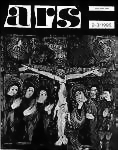
Časopis ARS 28 (1995) 2-3
Ingrid CIULISOVÁ
Lesk a bieda slovenskej kunsthistórie II. Slovenský dejepis umenia 1948 – 1968[The Glory and the Misery of Slovak Art History II. Slovak History of Art 1948 – 1968]
(Resumé)
The years following World War II were extremely difficult for Slovak history of art. Many of the domestic monuments of art still not put into an inventory were destroyed, lost or moved abroad. Communists nationalized or confiscated the rest after their coming into power in 1948. The conditions of modern painting became complicated after closing of state borders. Slovakia was still missing some national, art-oriented institutions. It was necessary to establish e.g. Slovak National Gallery, to build up its collections, to establish the painting academy that would educate domestic painters. The number of educated, professional historians of art in Slovakia was very low and any kind of specialization was impossible. For these reasons Slovak history of art was substantially supported by Czech historians of art even after 1948. Especially helpful were in the first stage Karel Šourek, Vojtěch Volavka and Václav Mencl. Promising perspective was radically changed in the fifties. The doyen of the Slovak history of art Vladimír Wagner (1900 – 1955) died, structuralist Jaroslav Honza Dubnický stopped working from ideological reasons and Václav Mencl came back to Czechia. The Stalinist regime principally changed also the social statute of the historian of art. Open, based on principles of liberalism and the functioning market came to an end. The Communist monopoly took control of it. The new patron and sponsor – leading Communist politicians – exclusively decided the market success of paintings. A painter ceased to be dependent on an expert view of the historian of art. The one became good for nothing and was gradually socially and financially degraded. This was also the case of historians of art working with so-called old art because the standpoint of the Communist power to monuments of old art was ideologically determined.
The progressive transformation of the historian of art social position in Slovakia after 1948 resulted from an absolutely new mission of the history of art. The main purpose was to reevaluate the national painting history from a view of the class struggle and theoretically justify the socialist art – so-called socialist realism (sorela). The Slovak history of art was established in the fifties as a scientific discipline. The Institute of History of Art was established within the Slovak Academy of Sciences, directed by Marian Váross (1923 – 1988). The first scientifically oriented domestic periodical in the history of art – Ars – was introduced by his initiative. By the end of the sixties a lot of significant Slovak historians of art, e.g. Anna Petrová, Mária Malíková, Libuše Cidlinská, Iva Mojžíšová, Ladislav Saučin and others made their debut. The development of the discipline of art history in Slovakia in the sixties was determined particularly by Marian Váross, Radislav Matuštík and Tomáš Štraus. The leading personality in the so-called old art was Karol Vaculík (1921 – 1992), for many years the director of Slovak National Gallery. Younger Czech historians of art, e.g. Jaromír Homolka, Josef Krása, Vlasta Dvořáková, Karel Stejskal, took a great part in the research of Slovak monuments. Thanks to the efforts of Alžbeta Güntherová-Mayerová the first inventory of Slovak monuments of art was finished and published by the end of the sixties. Published works however acknowledged that the methodological base of the Slovak history of art is still a heritage of the Viennese school of art history from the first third of this century. The era of Dubček and Socialism with a human face partially relaxed also ideological fetters of the history of art. Numerous Slovak historians of art paid a hard tax for their activity after failure of the Prague spring. R. Matuštík and T. Štraus forcedly left the University in Bratislava; M. Váross forcedly left the Slovak Academy of Sciences, and others lost their professional jobs, some decided to leave the country. Many important works of the Slovak history of art were put on the index and they were officially made accessible only after 1989.